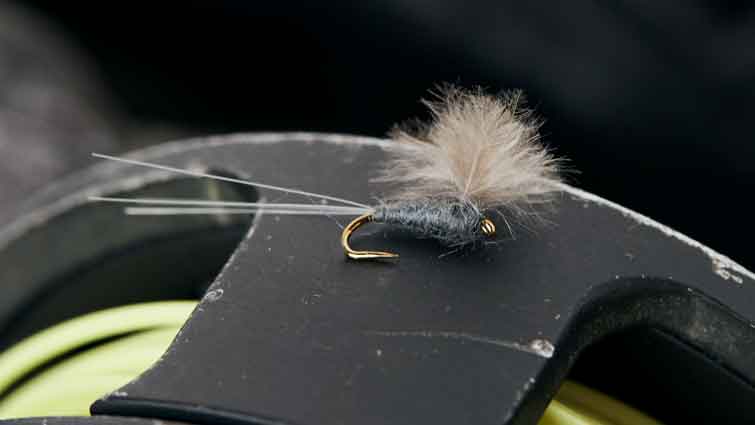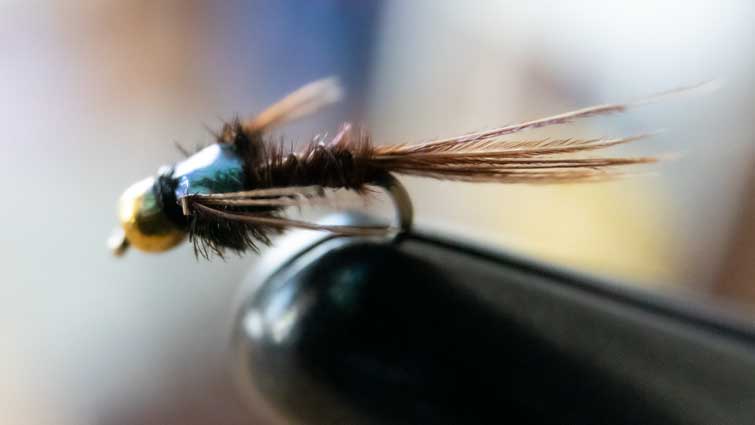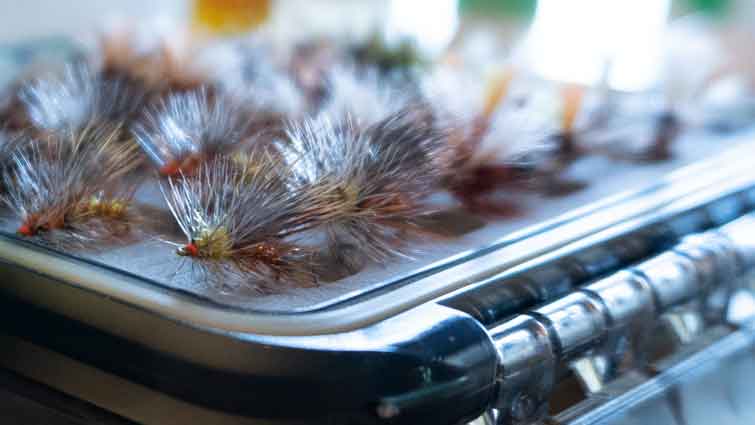Brown and brook trout typically spawn in the fall when water temperatures drop below 60°F. During this time, their main focus shifts to accumulating energy for the demanding spawning process, which means they don't feed as actively. However, brown trout become pretty territorial, making streamer fishing particularly effective.
Rainbow trout, on the other hand, spawn in the spring, usually between February and May. The timing varies by elevation: those at lower elevations tend to spawn in February and March, while those at higher elevations spawn in March and April.
Choosing a fly that mimics the appropriate hatch or baitfish and ensuring its size is a very effective tool in your fly fishing arsenal to catch that trout of a lifetime.
So what size fly should you use for trout?
As a general rule we recommend matching the hatch and going smaller on flies for larger, more pressured trout, especially tailwaters. Trout prefer nymphs, streamers, and dry flies. Dry flies 12-16 are ideal for trout as well as Nymphs size 18-22.

But what size fly should you choose? Since there are thousands of insects that trout feed on alone, tying on the perfect fly is a daunting task. Luckily, there are a few general patterns that work on most trout. Below you will find a list of the most common types of flies and their corresponding size/weight recommendations for trout.
The Right Size Fly for Trout
Trout have a highly developed sense of sight, especially regarding movement, making brightly colored flies a productive choice. Flies tied with feathers work well because they look a lot like many insects that trout eat.

When it comes to the color and size of the fly to use, there is no hard and fast rule when it comes to trout, therefore utilize patterns with many hues so you may replicate all of the various life stages in their diet and sizes between 12-18 will cover most situations.
Flies recommended for catching trout :
- Caddis Pupa
- Copper John
- Beadhead Prince Nymph
- Blue-Winged Olive
- Stimulator
Typically sizes 12-18 are best. Even when caddis are hatching, instead of mayflies, the Adams will draw strikes. When midges are emerging, it's also hard to top a tiny Adams in sizes 20-24.
Nymphs Size 16-22
You can't go wrong with a pheasant tail, hare's ear, prince nymph, or gold ribbed hare's ear. Let the fly sink to the bottom and dead drift them through the feeding zone. Typical colors are black, mahogany, brown, dark olive, purple/red, and red.
Nymph sizes 16-22 will work for the majority of situations. As a rule, if you see a lot of large nymphs in the water, your best bet is to use a larger fly. If you're seeing tiny nymphs go with a size 18 or below.

Dry Flies 12-22
Dry flies should be size 12-22. The Adams is a top dry fly choice for most trout species. Other suitable options include Elk Caddis, Stimulator (black), or Parachute Adams.
Black and brown are standard colors here as well. Try black, dark olive, and brown for these patterns. For trout, dry flies are best fished on the water's surface.
To fish dry flies successfully, you need fish either feeding on the surface or gazing up for food. The optimum moment to fish a dry fly is during the hatch when the fish are paying close attention to the surface, and emerging insects or falling insects enter the water.

Streamers Size 4-6
Trout love streamers throughout the year. Use a zonker with a bunny strip behind it in browns and olive, black/purple in late winter, and white/orange in summer. You can also try leeches or sculpins for larger fish.
During the late season, you'll find large mayflies near the banks of rivers and lakes, especially in slower currents where there is plenty of structure under which they can hide. In the early morning and evening, trout often feed on this type of mayfly underwater. In these cases, a heavy nymph or streamer pattern will work best to add movement and attract the trout's attention.

For this type of fly, go with a weight that allows it to land softly on the surface and avoid snagging on obstacles below water. Use a bead head pattern to keep it from sinking into the weeds, and use a wiggle strip for added flash.
Streamers are a very popular choice for trout. They resemble:
- Baitfish
- Leeches
- Crayfish, and
- Other large food sources of trout.
Typical streamer patterns include Muddler Minnow (black/red), Slump Busters (various shades of brown and natural earth tones), and Zonkers (various colors).
Wet Fly Size 4-10
Wet flies size 4-10 should be used and should be visible on the surface of the water. In mid-season, look for larger mayflies. Wet flies are important to use when fishing for trout. This is because the size of the fly will make it easier to fish in all sorts of conditions, both at different times of the year and if the fish are feeding on other foods.

For this type of fly, go with a weight that allows it to land softly on the surface and avoid snagging on obstacles below water. A bead head pattern can help keep it below surface tension and increase casting distance. Egg patterns and leech patterns can also work if you let them sink.
Choose a bead head pattern to keep it from sinking into weeds. Use larger sizes if trout are aggressive or very large mayflies are present; use smaller/lighter flies for more stealthy, cautious fish.
How Flies are Sized
Flies are sized according to the diameter of a hook. Flies are sized according to a gauge system that measures a hook's width, length, and gap. Hooks vary widely in shape, profile, and gape (how far the hook opens when it's set). Flies will range from very fine, delicate patterns to large bulky ones.

The size of flies gets more significant as the hook gets smaller. A size 4 is a reasonably large fly, and a size 24 is a tiny fly. After size two on the large end of the hook spectrum, hook sizes go to 1/0, 2/0, and so on. The hook size only really applies to the gape of the hook, which is the distance between the point and the hook shank.
The length of the hook is designated as 1#, 2#, 3#, etc., indicating that the hook shank is 1, 2, or 3 times the length of the gap. Most basic flies are tied on 2# long hooks, although there are many exceptions. Nymph and streamer hooks are made from a heavier wire to sink faster. Dry fly hooks are fine wire, so they aren't too heavy.

Sometimes you'll hear anglers referring to natural insects and other invertebrates with hook sizes. This means that you would use about that size of fly to imitate that bug.
There are also some smaller & larger sizes, which tend to be either for specific patterns or specific species. But as a general rule, go smaller on flies for larger, more pressured trout, especially in tailwaters.
What Color Flies Do Trout Like?
Trout feed on various insects and other invertebrates such as
- Midges
- Mayflies
- Caddis
- Stoneflies
- cuds or Sowbug
- Damselflies or Dragonflies,
- Terrestrials
Trout typically feed in a specific way. They will swim with an open mouth and rub their bodies along the bottom of the river, lake, or stream. The fish will eat whatever insect life is accessible at the time, including both larvae and adults.

The most effective solution is to match the hatch; trout will eat whatever is hatching. The trout's eye is more sensitive to the red wavelength than a human's, and it has less capability to detect green than any other color.
When choosing what color to fly fish with, bring a selection of nymphs so you will have a variety of colors to choose from. Use dark-colored patterns when fishing murky water and light-colored flies when there is good visibility on the surface. In clear water situations, use more contrasting colors on your fly fishing flies, such as white on black or vice versa, for deepwater applications where sight is ineffective.

Fishing for brown trout? You'll want to make sure that your fly fishing flies match the hatch by using natural-looking materials like feathers and fur-like synthetics. If possible, use fly fishing flies that aren't too bright. Shiny colors are highly visible to trout and will spook them more easily than duller colors, including:
- Earth tones like browns,
- Greens
- Grays, and
- Brown trout like darker colors on their food sources because they tend to be bottom feeders.

Bass Anglers also use the same color theories for coloring fly fishing lures. If you're bass fishing in clear water, choose something bright; if the water is cloudy, go with a more natural color. Like brown trout, Bass have been shown to eat whatever bug is available at the time, so you'll want to match the hatch as closely as possible. Remember that any insect over an inch long can usually catch smallmouth bass, so it's essential to have a variety of bass fishing flies.
Artificial flies resembling these insects can be used to catch brown trout. Mature brown trout are attracted to ants, hoppers, beetles, and other attractor patterns at this time.

How Are Trout Flies Sized?
Flies are annotated by size — the higher the number, the smaller the fly. Generally, nymphs and dry flies in sizes 12 to 16 are the most common, but size 20 or 22 dry flies are often used. Streamers in sizes 4 to 6 tend to be most useful.
What Is the Best Fly for Trout?
First, give the water a close inspection. Second, tie on an imitation that looks like the most likely food supply if you see feeding fish. Third, if there aren't any feeding fish to be seen, try using an attractor that suggests a bug or baitfish typical to the region.

When choosing a fly for trout, matching the hatch is always essential, so bring along a variety of nymphs that match up with what may be hatching at any given time during your day on the river or lake.
It will depend on the size of the stream and trout you are fishing. For a general rule, it's best to use small flies when fishing clear water and larger patterns in murkier conditions. Try using earth tones like browns, greens, grays, blacks for brown trout when fishing from a boat or bank.
What Size Flies Are Best for Trout?
Above all, match the hatch. Be aware of what is typically hatching at the time, and make sure to bring a variety of nymphs and dry flies with you on your fishing trip. Size green, brown, and black fly patterns for low visibility and bright colors if the water is clear. Make sure that your flies are tied correctly so they can do their job correctly.
The best flies for brown trout include Dry flies 12-16, wet flies 12-16, streamers 4-6, ideally. You may get by with others at times, but you should have a range of sizes and colors in your box to handle all possibilities.
Because sizes 12-18 are ideal, nymphs in this range are best. It isn't easy to top a tiny Adams in sizes 20-24 when midges emerge. (It's difficult to tie in wings that small, therefore skip them from the pattern when making flies in these petite sizes.)
The trout's eye is more sensitive to the red wavelength than a human's, and it has less capability to detect green than any other color. When choosing the size fly, the most effective solution is to match the hatch; trout will eat whatever is hatching. Trout feed on various insects and other invertebrates such as shrimp, caddisflies, stoneflies, and mayflies.
When choosing what color fly you should use, many factors need to be considered, like where you are located ( or river), water clarity, and other factors. Therefore, it is essential to study the local conditions before each fishing trip.






1 comment
Thomas Ford
Very good information for us beginner fly fisherman, Thank You!
Very good information for us beginner fly fisherman, Thank You!